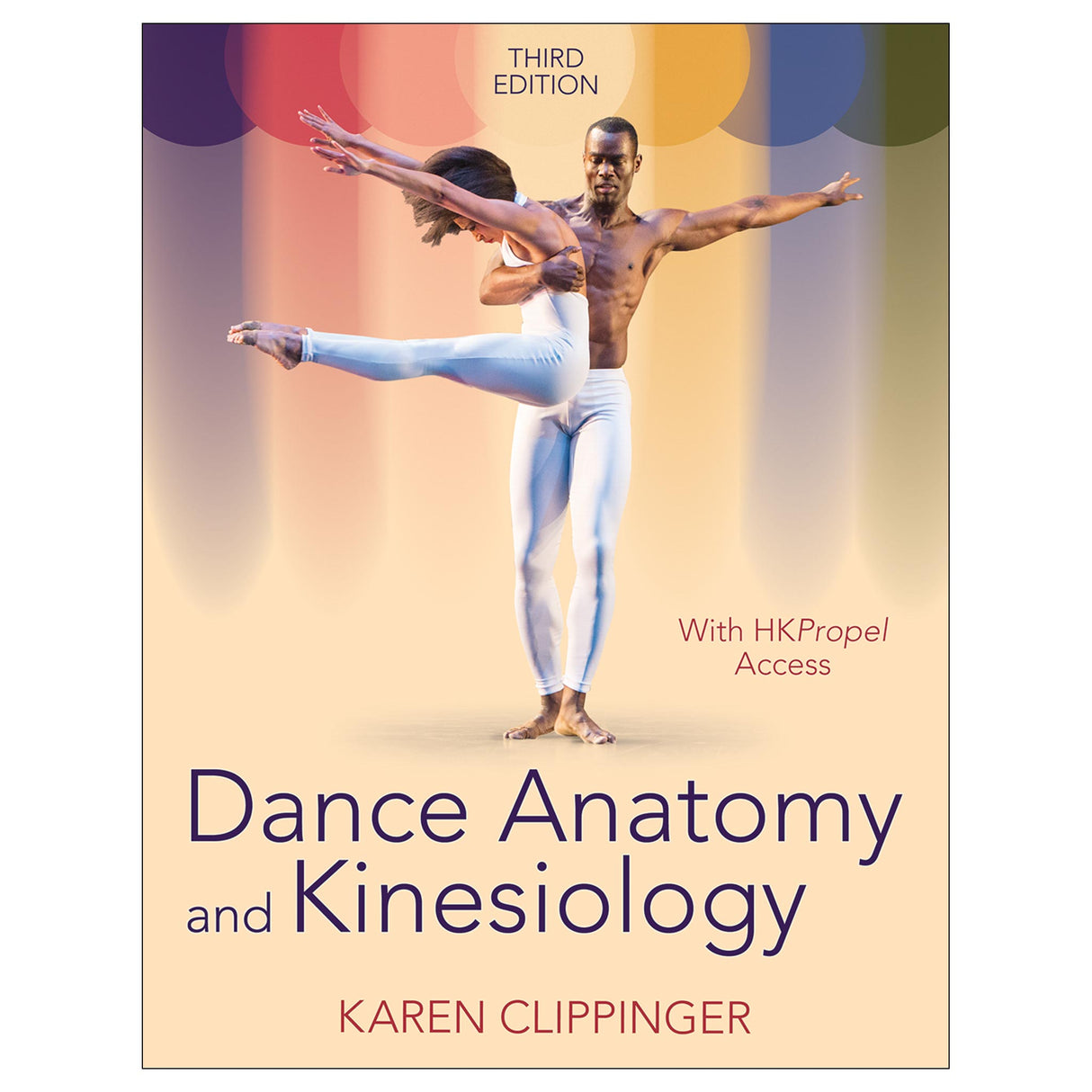Dance Anatomy and Kinesiology 3rd Edition Ebook With HKPropel Access
Author: Karen Clippinger
$96.00 USD

What’s New?
In an effort to further enhance learning, Dance Anatomy and Kinesiology offers a wealth of new material and tools to make this edition the best yet:
- Nearly 300 anatomical illustrations—now in full color to clearly show muscle movements and technique considerations, setting the book apart from others in its field
- A new introductory chapter to cover basic terminology all in one place
- A new recurring Understanding Check element that helps students demonstrate their grasp of the material before moving on
- An updated suite of online instructor and student ancillaries to support the text
- New interactive art and table activities that aid with identifying bones and muscles and learning muscle actions, delivered online through HKPropel
- More diverse dance styles addressed throughout the book and represented in photographs
Through HKPropel, students have access to interactive Understanding Check activities, flash cards, practice quizzes with automatic feedback, and 19 video clips that demonstrate technique and offer correction guidance.
The final chapter is revised to provide a summary and applications, including more practical content in the form of summary figures or tables for bones, joints, muscle actions, and alignment evaluation, as well as sample mat exercises for dance conditioning. And throughout the book, Clippinger has updated content to simplify, add more practical material, and share best practices for injury prevention and rehabilitation.
Primary Focus
The third edition of the book retains its emphasis on presenting the anatomical and kinesiological material that is essential for dancers to understand. The text includes descriptions of joint structure, key muscles, movement analysis, sample strength and flexibility exercises, common alignment problems, select joint mechanics, and special considerations for dance for each region of the body.
The third edition still features the Concept Demonstration and Dance Cues special elements. The former provides movement experiences for dancers to better understand potentially difficult concepts, while the latter helps the dancer reflect on the anatomical basis of commonly used cues used in teaching dance technique.
Empowers Instructors and Dancers
This new edition of Dance Anatomy and Kinesiology will give teachers a clearer picture of the anatomical and kinesiological factors that aid in generating technique cues and identifying technique problems, and it will help them become more effective and empower dancers to realize their potential and artistic vision.
Note: A code for accessing HKPropel is included with this ebook.
Audience
Textbook for undergraduate and graduate courses in anatomy, kinesiology, technique, conditioning, or injury prevention. Reference for dance science professionals, dance instructors, dancers, Pilates instructors, and Pilates enthusiasts.Positional and Directional Terms
Rotary Motion, Anatomical Planes, and Axes
Joint Movement Terms
Summary
Chapter 2. The Skeletal System and Its Movements
Bone Composition and Structure
The Human Skeleton
Classification and Structure of Joints
Joint Mechanics in Functional Movement
Summary
Chapter 3. The Muscular System and Its Movements
Skeletal Muscle Properties
Microscopic Structure of a Muscle Fiber and Muscle Contraction
Muscle Architecture
Muscle Attachments to Bone
Contribution of Connective Tissue to Muscle Behavior
Muscles, Levers, and Rotary Motion
Types of Muscle Contraction and Torque
Muscular Considerations in Functional Movement
Muscles and Movement Analysis
Summary
Chapter 4. The Spine
Bones and Bony Landmarks of the Spine
Joint Structure and Movements of the Vertebral Column
Description and Functions of Individual Muscles of the Spine
Muscular Analysis of Spinal Movements
Ideal Spinal Alignment and Common Deviations
Spinal Mechanics
Special Considerations for the Spine in Dance
Spine Injuries in Dancers
Summary
Chapter 5. The Pelvic Girdle and Hip Joint
Bones and Bony Landmarks of the Hip Region
Joint Structure and Movements of the Pelvic Girdle
Joint Structure and Movements of the Hip
Description and Functions of Individual Hip Muscles
Muscular Analysis of Hip Movements
Alignment and Common Deviations of the Hip Region
Pelvic and Hip Mechanics
Special Considerations for the Hip Region in Dance
Hip Injuries in Dancers
Summary
Chapter 6. The Knee and Patellofemoral Joints
Bones and Bony Landmarks of the Knee Region
Joint Structure and Movements of the Knee
Description and Functions of Individual Knee Muscles
Muscular Analysis of Knee Movements
Alignment and Common Deviations of the Knee
Knee Mechanics
Structure and Movements of the Patellofemoral Joint
Patellofemoral Alignment and the Q Angle
Patellofemoral Mechanics and Compression Forces
Special Considerations for the Knee Region in Dance
Knee Injuries in Dancers
Summary
Chapter 7. The Ankle and Foot
Bones and Bony Landmarks of the Ankle and Foot
Joint Structure and Movements of the Ankle and Foot
Description and Functions of Individual Ankle–Foot Muscles
Muscular Analysis of Ankle–Foot Movements
Alignment and Common Deviations of the Ankle–Foot
Ankle–Foot Mechanics
Special Considerations for the Ankle and Foot in Dance
Ankle and Foot Injuries in Dancers
Summary
Chapter 8. The Upper Extremity
Bones and Bony Landmarks of the Shoulder Complex
Joint Structure and Movements of the Shoulder Girdle
Joint Structure and Movements of the Shoulder
Description and Functions of Individual Muscles of the Shoulder Complex
Muscular Analysis of Movements of the Shoulder Complex
Alignment and Common Deviations of the Shoulder Complex
Mechanics of the Shoulder Complex
Bones, Joint Structure, and Movements of the Elbow Joint
Description and Functions of Selected Individual Elbow Muscles
Muscular Analysis of Elbow Movements
Alignment and Common Deviations of the Elbow
Bones, Joint Structure, Movements, and Muscles of Selected Other Upper Extremity Joints
Special Considerations for the Upper Extremity in Dance
Upper Extremity Injuries in Dancers
Summary
Chapter 9. Summary and Applications
Structure, Alignment, and Mechanics of Key Joints
Key Muscles and Their Movements
Sample Conditioning Exercises
Observation and Corrective Measures for Key Alignment and Technique Problems
Anatomical Movement Analysis Schema for Whole-Body Movements
Sample Anatomical Movement Analysis with Research Supplements
Dance Movement Cues
Summary
All ancillaries are free to adopting instructors through HKPropel.
Instructor guide. Includes a sample syllabus and course outline, chapter outlines, lab assignments, and sample tests.
Presentation package. Features more than 600 PowerPoint slides of text and graphics from the book that can be used for class discussion and presentation. The slides contain nearly 300 pieces of art and over 100 photos. The slides in the presentation package can be used directly within PowerPoint or printed to make handouts for students. Instructors can easily add, modify, and rearrange the order of the slides.
Instructors also receive access to all student materials in HKPropel. For Dance Anatomy and Kinesiology, Third Edition, this includes interactive art and table activities, video clips, practice quizzes with automatic feedback, and flash cards.










